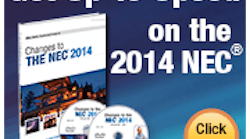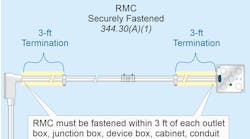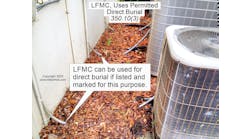Q. What uses are permitted by the NEC for power and control tray cable (Type TC)?
Scroll Down to See Answer
Underlined text indicates a 2017 Code change.
A. The permitted uses of power and Type TC cable include [336.10]:
(1) Power, lighting, control, and signal circuits.
(2) In cable trays including those with mechanically discontinuous segments up to 1 ft.
(3) In raceways.
(4) Outdoor locations supported by a messenger wire.
(5) Class 1 circuits as permitted in Parts II and III of Art. 725.
(6) Nonpower-limited fire alarm circuits if in accordance with Sec. 760.49.
(7) Industrial establishments where the conditions of maintenance and supervision ensure that only qualified persons service the installation.
(8) In wet locations where the cable is resistant to moisture and corrosive agents.
(9) In one- and two-family dwellings, Type TC‑ER cable is permitted in accordance with Part II of Article 334. Note: The “ER” marking on Type TC-ER cable identifies the cable as suitable for exposed run use in accordance with UL 1277.
Exception: Where Type TC cable is used to connect a generator and its associated equipment, the cable ampacity limitations of Sec. 334.80 or Sec. 340.80 don’t apply.
Informational Note 1: Type TC cable that’s suitable for pulling through structural members of a dwelling unit will be marked “TC-ER-JP.” Note: The “JP” marking on Type TC-ER-JP cable identifies the cable as suitable to be pulled through wood framing members because the cable has met the joist pull testing requirements of UL 1277.
Informational Note 2: Control and Class 1 power conductors within the same Type TC cable are only permitted where the conductors are functionally associated with each other in accordance with 725.136.
(10) Direct buried where identified for direct burial.
These materials are provided to us by Mike Holt Enterprises of Leesburg, Fla. To view additional Code training materials offered by this company, visit www.mikeholt.com/code.




